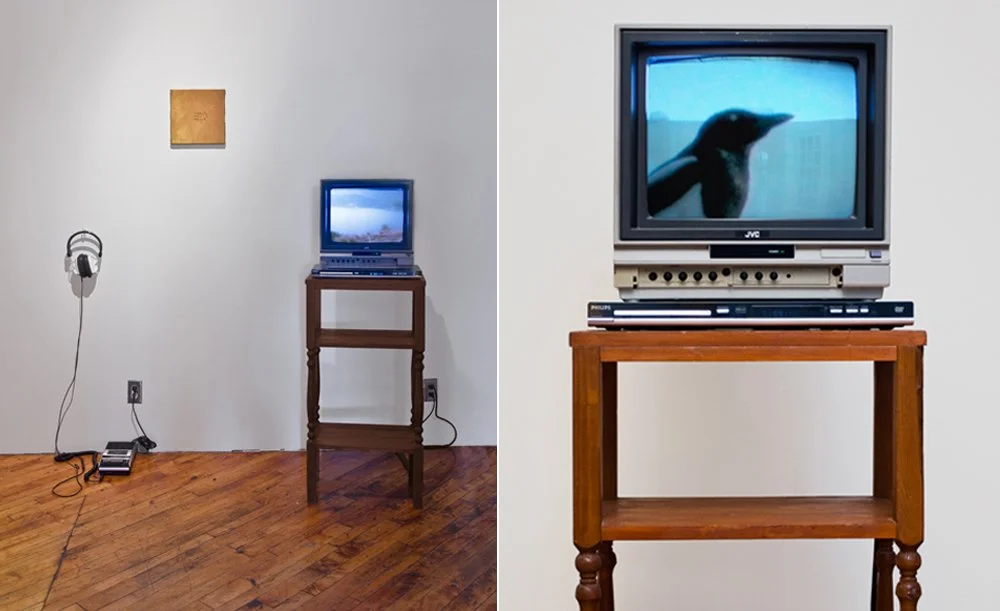Play Rewind
MFA Thesis Exhibition, VMAC Gallery, Toronto ON, 2012
Play Rewind is a co-production of video, sound, and textiles, creating an experience filled with stutters, skips, overlaps, and gaps. I am interested in activating the video image to explore visualization of memory and time through repetition. I envision remembering as a form of repetition and have attempted to create an image of time as it collapses back into memory. The malleability of the video medium is used to exercise these recursive temporal collapses and overlays, while the landscape in the video stands as a constant and reliable form on which an image of what remembering might look like is projected.
As an exhibition, Play Rewind pushes the boundaries of video's linearity in search of a dimensionality of space and time that is fluid and changing. Embedded in the soundtrack, the echoing and stumbling audio for each video bleeds into the space, casting layers of time and space over the installation. Amongst the chaos of the stuttering videos and stumbling audio the embroidered drawings hang still—anchoring the eye and revealing a geometry that devolves over time. Each embroidered drawing uses a past and unseen moment to envision the next drawing, slowly disappearing as the handmade process diminishes, becoming imperceptible in space and time.
Book of Revelations
This video is edited in such a way that sharp, spontaneous gestures oscillate the profile back and forth so that she is shaking her head. Looking back and forth from the mountains to the camera, testing her extroversion towards the landscape then returning inwards and reflexive towards the camera. The audio in Book of Revelations functions like a sound-effect; when the silhouette turns her head a grumbling audio track plays; when the profile is still and at a momentary rest the sound is at ease.
Sails
Sails expands the image context from a suspended landscape to a valley with a bridge, a shore, a lake, a town. Sails looks up and into the small movements of life at the foot of an unfazed mountain landscape and up to a magpie perched on a dying pine’s limbs. A pulsing bridge, a tottering boat, a teetering city center, a twitching saw mill, a spasm of peaks and valleys all flicking and falling into a sequence.
Page Turner
Page turner, simply titled as the video focuses on a stalled moment in between a new and old page being turned, is stutters in a moment of change.
you may never
You May Never is a focused study on an instant of video; it is composed of a 4-second section of scrubbed footage that is repeated, creating a 4:30 min video. The movement in this video is generated by camera functions. The camera shifts along the horizon, switching from out-of-focus to in-focus, while refracted sunlight slices into the lens.
three flowers
A figure enters the frame walks to her mark turns towards the camera and stops. Poses. Pauses. Turns and continues to the next. The figure is also holding a sign that becomes an extension of the body; it rotates and angles towards the camera as the figure does; the sign is raised above her head in proclamation or lowered to resemble a human sandwich board. Rarely does the sign fall away. Only when the figure is leaving or entering the frame is the sign lowered to her side. I am her, I am the figure; in each video the silhouetted figure is me and the words (Three Flowers) reference a memory of mine.
The editing process used in these videos transforms the linear temporality inherent in the structure of video into a system of seamless transitions. The landscape image is re-produced through an editing process I developed that generates variations in the perception of time. This technique abandons the control found in traditional editing software, and in substitution focus is placed on methodologies associated with chance and lyrical movement. Through this process a shuffling or stuttering effect is generated on the video and audio simultaneously, which disrupts the succession of events found in the original recording. This process of editing also allows me, it editor, to act intuitively, in a manner that fosters discovery from which I can narrow in on images and sequences.
This process involves capturing the edited movements live. I scrub over footage by sweeping the cursor over the timeline. I am interested in the two forms of tracing movement; that being the literal movements of space recorded in the video, as well as this post-process of recording the movements of the editors hand as it physically effects the footage. With this focus on editing, I am able to superimpose new movements onto pre-existing movements, which I feel opens into a dialogue on the nature of critique, selection, and the evaluation of space. I am compelled to navigate through post-production in this way as it includes the flaws and hesitation of the creative process.





